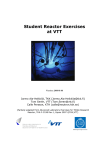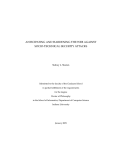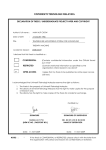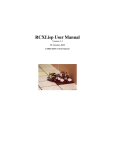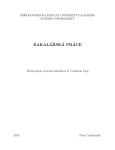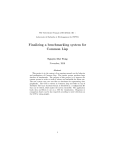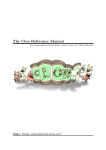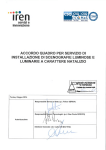Download PORK Object System Programmers` Guide
Transcript
PORK Object System
Programmers' Guide
Ora Lassila
CMU-RI-TR-95-12
The Robotics Institute
Carnegie Mellon University
Pittsburgh, PA 15213
April 1995
c 1995 Ora Lassila
This research has been supported in part by the Advanced Research
Projects Agency under contract F30602-90-C-0119 \Flexible MultiAgent Coordination" (as part of the ARPA/Rome Labs Planning
Initiative) and under contract F30602-91-C-0014 (under subcontract
to BBN Systems and Technologies), by the National Aeronautics
and Space Administration (NASA) under contract NCC 2-531, and
by the CMU Robotics Institute.
ii
Abstract
PORK is an object system which brings a conventional object-oriented language
closer to the requirements of frame-based programming. It only provides a very
limited set of features (on top of the base object system itself), and aims to achieve
seamless integration with conventional programming. PORK is implemented as
a portable metalevel extension of the Common Lisp Object System (CLOS). It
extends CLOS by adding the following concepts:
Named objects. These simplify debugging and linked frame model construc
tion. Collections of named objects (called "namespaces") can also be used
as a low-level implementation vehicle for knowledge bases.
References to nonexisting named objects. Programs can manipulate objects
that have not yet been created. This greatly simplies denition of complex
linked frame models with circular references.
Slots with multiple values, and a mechanism for dening an access interface.
Automatic updating of inverse slots.
iii
iv
Contents
1 Introduction
1.1 Motivation
1
: : : : : : : : : : : : : : : : : : : : : : : : : : : : : : :
1.2 Overview of Features
: : : : : : : : : : : : : : : : : : : : : : : : :
2 Programming with PORK
: : : : : : : : : : : : : : : : : :
7
: : : : : : : : : : : : : : : : : : : : : : :
8
: : : : : : : : : : : : : : : : : : : : : : : :
9
2.2 Using Many-Valued Slots
2.4 Dening Your Own Access Methods
: : : : : : : : : : : : : : : : :
11
: : : : : : : : : : : : : : : : : : : : : : : :
15
: : : : : : : : : : : : : : : : : : : : : : : : : :
18
2.5 Implementing Daemons
2.6 Using Slot Options
2.7 Extending the System
2.8 Using Namespaces
3
7
2.1 Mixing PORK and \Plain" CLOS
2.3 Using Inverse Relations
1
: : : : : : : : : : : : : : : : : : : : : : : :
20
: : : : : : : : : : : : : : : : : : : : : : : : : :
21
3 Programming Interface
25
3.1 Named Objects
: : : : : : : : : : : : : : : : : : : : : : : : : : : :
25
3.2 Class Denition
: : : : : : : : : : : : : : : : : : : : : : : : : : : :
28
v
3.3 Instance Creation
: : : : : : : : : : : : : : : : : : : : : : : : : : :
4 Metaprogramming Interface
4.1 Named Objects
4.2 Namespaces
29
31
: : : : : : : : : : : : : : : : : : : : : : : : : : : :
31
: : : : : : : : : : : : : : : : : : : : : : : : : : : : : :
33
4.3 Forward References
: : : : : : : : : : : : : : : : : : : : : : : : : :
36
4.4 Frame Objects
: : : : : : : : : : : : : : : : : : : : : : : : : : : : :
37
4.5 Frame Classes
: : : : : : : : : : : : : : : : : : : : : : : : : : : : :
38
: : : : : : : : : : : : : : : : : : : : : : : : : : : : : : : :
41
4.6 Relations
5 Design and Implementation Notes
5.1 Object Naming Mechanism
45
: : : : : : : : : : : : : : : : : : : : : :
5.2 Forward References and Deferred Access
5.3 Class Denition
45
: : : : : : : : : : : : : :
46
: : : : : : : : : : : : : : : : : : : : : : : : : : : :
48
5.4 Instance Creation and Initialization
: : : : : : : : : : : : : : : : :
49
: : : : : : : : : : : : : : : :
50
: : : : : : : : : : : : : : : : : : :
51
: : : : : : : : : : : : : : : : : : : : :
53
5.5 Common Lisp System Compatibility
5.6 Reliance on Common Lisp MOP
5.7 Porting to Other Platforms
vi
Acknowledgements
The PORK system, ocially started in 1992, was designed for use in the reengineering of the OPIS/DITOPS scheduling system. The work was supported in
part by the Advanced Research Projects Agency under contract F30602-90-C-0119
\Flexible Multi-Agent Coordination" (as part of the ARPA/Rome Labs Planning
Initiative) and under contract F30602-91-C-0014 (under subcontract to BBN Systems and Technologies), by the National Aeronautics and Space Administration
(NASA) under contract NCC 2-531, and by the CMU Robotics Institute.
The questions and comments from the users of PORK often made me notice
confusing details either in the system or in the early drafts of the manual (this is
not to say that there wouldn't be any confusing things in this document). I would
like to thank all the people who in this way (or various other ways) contributed
to the design of PORK: Gilad Amiri, Marcel Becker, Dina Berkowitz, Ali Safavi,
Stephen F. Smith and Chris Young. I owe special gratitude to Steve for the faith
he had in letting me take a drastic approach to the redesign of DITOPS.
Since PORK is the long-awaited Well Done BEEF, I would also like to extend
my thanks to all the people at Helsinki University of Technology who helped me
during the initial design phase of WDB. Last, but most certainly not least, for all
her encouragement I would like to dedicate this work to my wife Marcia who by
now is probably sick and tired of all these meat products...
Pittsburgh, April 1995
Ora Lassila
vii
viii
Chapter 1
Introduction
Initially, PORK was designed for use in the re-engineering of a large knowledgebased system, the OPIS/DITOPS scheduling system [13, 14, 15, 16]. The purpose
of the re-engineering eort was to move from an old frame-based implementation
to a more maintainable object-oriented version. This chapter introduces PORK
and provides some background for the motivation of its design.
The name PORK stands for \Programmable Objects for Representing Knowledge." (earlier the system was called \Parsifal" but because of a conict with the
name of an existing system this name had to be dropped). From the design standpoint PORK has its heritage in the \well done BEEF" eorts [11] undertaken at
the end of the BEEF project [3, 9, 10].
1.1 Motivation
The concept of frames [12] and the idea of a frame system have been very popular
as an easy-to-understand paradigm for representing complex data. The fundamental idea is simple: frames are the system's basic objects, they represent real-world
concepts and phenomena; frames have named attributes, slots, and slots can be
assigned values. Inheritance allows slot values to be used as defaults. From the
standpoint of programming it is perhaps unfortunate that what frame systems
are really good for is representing things. In an attempt to make it easier to
use frame systems in a normal programming context, designers of frame systems
have often added features that add \object-oriented" programming capabilities
1
to frame systems (examples of systems like this are KEE [1, 18], CRL [19] and
BEEF [3, 9, 10]).
There are dierences between \real" object-oriented programming and the framebased avor of object programming. First, there are denite dierences between
inheritance mechanisms: In object-oriented programming systems, types usually
form a taxonomy, and inheritance is understood as the propagation of functional
and structural information in this hierarchy. Often the propagation takes place
at denition time; when an object-oriented program is running the inheritance
hierarchy is more or less xed. In frame systems, however, inheritance is used
to propagate default slot values in the type hierarchy. Inheritance is typically
dynamic in nature, i.e. takes place at run time. This allows default values to
be changed during program execution. Frame systems may also allow the use
of alternate inheritance paths in addition to the usual conceptual subsumption.
These dierences in inheritance are closely related to dierences in program access
to the type hierarchy. In an object-oriented programming system, only instances
are objects of the system. Systems that oer facilities for metaprogramming [2, 17]
also allow the type hierarchy to be accessed. In some frame systems types do not
fundamentally dier from instances, and program access to the type hierarchy is
possible without any meta level.
What frame systems lack with respect to object-oriented programming systems
is proper facilities for data hiding and support of encapsulation. Object-oriented
programming systems typically support and enforce encapsulation, allowing objects to be manipulated through a well-dened function interface. Frame systems
do not usually restrict access to slot values of any frames in any way.
Frame systems, as opposed to object-oriented programming systems, are usually
designed for representing knowledge, with the programming aspect not necessarily considered very important. Object-oriented programming systems in general
are not adequate for knowledge-based systems programming. For a more detailed
discussion on frame systems vs. object-oriented programming systems, see for
example [8]. Many attempts have been made to bring frame-based programming
closer to mainstream programming by adding object-oriented programming features. On the other hand, PORK brings some of the features of frame systems
into the realm of mainstream object-oriented programming. PORK achieves this
by adding some useful features from frame systems into a standard object-oriented
programming language.
2
1.2 Overview of Features
PORK is an object system which brings a conventional object-oriented language
closer to the requirements of frame-based programming. It only provides a very
limited set of features (on top of the base object system itself), and aims to achieve
seamless integration with conventional programming. The design of PORK draws
from experience with frame systems like CRL and KEE, and from the insight into
frame system design gained during the BEEF project [10].
PORK is implemented as a portable extension of the Common Lisp Object System
(CLOS, [17, pp.770-864]). It extends CLOS by adding the following concepts:
Named objects.
References to nonexisting (future) named objects.
Slots with multiple values, and a mechanism for dening an access interface
to these.
Automatic updating of inverse slots (these are similar to CRL's inverse
slots).
Otherwise PORK behaves exactly like standard CLOS, thus allowing PORK and
CLOS code to be freely mixed. PORK also has a metaobject protocol to allow
the system to be extended (for an introduction of metaobject programming we
recommend the book \The Art of the Metaobject Protocol" [6] which explains the
philosophy of metaobject protocols as well as documents the proposed standard
MOP for CLOS).
PORK, as an extension of CLOS, adheres to the class-instance paradigm. Other
frame systems, where the distinction between class-instance and prototype-instance
approaches is blurred (or those which completely adhere to the prototype-instance
paradigm), allow the programmer to do things which are not possible in PORK.
The most notable omissions are:
Dynamic addition of slots:
In PORK, all slots have to be dened in the
class. Furthermore, the whole idea of slot is dierent since a strict access
protocol is used; something that \looks like" a slot may not be one.
3
Dynamic inheritance: Changing slot default values specied in a class is a
\meta-level" operation and not necessarily meant to be done during program execution. There is no mechanism for changing a default value and
propagating this change to existing instances which have not modied the
slot in question.
1.2.1 Named Objects
An ordinary CLOS instance does not have a name. Reference to an instance is
possible only if a \link" exists from your data to the particular instance (either the
instance is a member of your data structures, or it is stored in a variable). The
PORK naming mechanism provides a mapping from names to instances. This
mapping is benecial for the following reasons:
It simplies instance references. One only has to know a name, and does not
have to store the instance in a specic place just because one would later
want to access it. This is very convenient when debugging.
It simplies instance identication. Symbolic names are easier to remember
and identify than machine addresses in hexadecimal format (and these may
even change during the execution of a program). Again, this is a feature
that makes debugging programs easier.
It makes it possible to refer to instances without the evaluation process. In
other words, it is possible to write constants which have instance references.
This simplies writing complicated linked instance models.
PORK prints named instances in a dierent manner than ordinary (anonymous)
instances. Here is an anonymous instance (from an imaginary class person):
#<person 0xEF9834>
whereas here is a named instance, called john-doe:
#<person john-doe>
4
PORK has a denition mechanism for the declarative creation of instances; the
denition macro is called definstance. Here is an example of how the instance
called john-doe might be created:
(definstance john-doe (person)
:full-name "Doe, John")
Here it has been assumed that the person class has an initialization parameter
called :full-name (one should not get confused, this initialization parameter is
here only for the sake of the example, it has nothing to do with the instance naming
mechanism). When creating instances using make-instance, the instance name
is given using the initialization parameter :name.
PORK also extends Common Lisp syntax by allowing a shorthand notation for
referring to named objects. To create a reference to an instance called john-doe,
one needs to write !john-doe. This notation is resolved at the time the expression
is read in. Please note that !john-doe is not the name of the instance, it is
the instance itself. Symbols that name objects are dierent from the objects
themselves (this is dierent from the approach taken, for example, in CRL and
BEEF, where the symbols that name objects are the actual objects).
If a reference is made to an instance that does not exist (i.e. the name is not found
in PORK's internal symbol table), a forward reference is created. A forward
reference is an object that represents the actual (future) instance until it gets
created. Of course, it is not completely equivalent to the instance it represents
(because, for one, it is of dierent class), but it will serve as an object that you can
pass on to other objects, store in data structures etc. When an attempt is made
to create the actual instance, the forward reference is changed using the CLOS
function change-class and it becomes the new instance. That way, references
made before the creation are valid and need not be updated.
One can also call slot accessors on forward references (more specically, slot writers, adders and removers; these are introduced in the next section). Especially in
the case of automatic inverse relations (again, refer to a subsequent section describing these) it may happen that a slot writer gets called on an object that \does
not exist" (i.e., a forward reference). These calls are deferred and executed when
the real object gets created. That way one can easily create cyclical structures
(e.g., doubly linked data structure).
The symbol table used by PORK can be changed, and the user can create new
symbol tables. In PORK, these symbol tables are called namespaces.
5
1.2.2 Relations
Relations in PORK consist of all slots with special behavior. These include manyvalued slots, inverse single-valued slots and inverse many-valued slots.
PORK implements many-valued slots as CLOS slots where the values are stored
as a list (these slots used to be called \multiple-valued" slots, but this name
is misleading because of the Common Lisp connotation of the term \multiple
values"). To make sure that nothing undesirable happens to the list of values,
a strict access protocol is enforced. This is done through the use of three new
types of slot accessors (compare these to the ones CLOS normally has: readers
and writers):
Adders are accessor functions that add values to a slot.
Calling an adder
once adds one value to a slot.
Removers are accessor functions that remove values from a slot. Calling a
remover once removes one value from a slot.
Cleaners are accessor functions that remove all values from a slot.
Here is an example of the use of an adder function (this assumes that !john-doe
and !jane-doe are instances of the class person which has an adder function
called add-child):
(add-child !jane-doe !john-doe)
i.e. !jane-doe was added to the list of children of !john-doe. Note that the value
to be added precedes the object to be added to. This is dierent from, say, the
convention of CRL where add-value's rst argument is the object to be added to.
The reverse order has been chosen so that adders and removers would be similar
to CLOS writer methods.
If you dene a slot with an adder and/or a remover accessor, you cannot use the
CLOS slot options :writer or :accessor, since the existence of these functions
would allow you to violate the many-valued slot access protocol. A cleaner can
only be dened if the slot has an adder and a remover.
6
Chapter 2
Programming with PORK
This chapter will give a \hands-on" introduction to programming techniques in
PORK. The examples will build gradually, introducing more features and techniques step by step; the examples are drawn from the production scheduling domain, modeling manufacturing facilities.
This manual is not an introductory text to programming with CLOS. Readers
unfamiliar with CLOS programming techniques are rst encouraged to study some
CLOS programming textbook, for example [5].
2.1 Mixing PORK and \Plain" CLOS
Since PORK is just an extension of CLOS, mixing PORK and CLOS programming is possible without trouble. For example, one can dene ordinary slots to
frame classes, and these will behave exactly like they would in \plain" CLOS.
For example, to model manufacturing resources we can dene a frame class called
resource. We will later introduce more details to this class:
(defframe resource (frame-object)
((total-capacity
:initarg :total-capacity
:reader total-capacity)))
7
Please note that in PORK we use the denition form defframe instead of the
usual defclass; the parameter syntax is the same. Furthermore, objects dened
using defframe have to inherit from frame-object (this is analogous to CLOS
classes inheriting from standard-object, except that in PORK the insertion of
the base class into the class precedence list has not been automated). One can
also make frame classes inherit from ordinary CLOS classes, but one is not allowed
to redene their existing slots to be many-valued slots. Any new slots that one
denes can use many values, however.
2.2 Using Many-Valued Slots
Access to many-valued slots is eected through adders, removers and cleaners.
Here is an example of how to dene an adder and a remover:
(defframe resource-group (resource)
((members
:initarg :members
:initform nil
:reader members
:adder add-member
:remover remove-member)))
The class resource-group gets created, together with the accessor functions
members (for reading the values of the slot), add-member (for adding values to
the slot) and nally remove-member (for removing values from the slot). The values of the slot can be initialized when an instance of resource-group is created,
by specifying the :members initialization parameter. Its value has to be a list, of
course; elements of that list will get added to the slot, one at a time, using the
adder function. Here is an example:
(definstance drilling-cell-1 (resource-group)
:members '(!drill-1 !drill-2 !drill-3))
Since the values of a slot are kept in a list, and this list is returned as a result of
a call to the slot's reader, it is an error to surgically modify this list (i.e. to use
functions like sort, delete, nconc etc.). If one needs to modify a list returned
by a many-valued slot's reader, the function copy-list should be used rst.
8
2.3 Using Inverse Relations
Let us assume a denitions of classes called resource and resource-group. Now,
resource-group maintains a list of its members. To make individual resources
aware of which groups they belong to, we will dene a slot groups in the resource
class to be the inverse of the slot members in the class resource-group. When
either slot gets modied, the other is automatically changed, too.
(defframe resource (frame-object)
((total-capacity
:initarg :total-capacity
:reader total-capacity)
(groups
:initform nil
:reader groups
:adder add-group
:remover remove-group
:inverse (:adder add-member
:remover remove-member))))
(defframe resource-group (resource)
((members
:initarg :members
:initform nil
:reader members
:adder add-member
:remover remove-member
:inverse (:adder add-group
:remover remove-group))))
Now the functions add-member and add-group are each others' inverse adders,
and correspondingly remove-member and remove-group are each others' inverse
removers. Notice how the denition of resource-group was changed to reect
the introduction of the inverse relation.
If one wants to use single-valued slots (i.e. ordinary CLOS slots) with inverse
updating, it is possible by specifying an accessor and an inverse accessor (instead
of adders and removers). For example, if we have an object class to represent a
9
resource time line (e.g., planned schedule for a resource), say, time-line, then
the resource and the time line can be linked using single-valued inverse relations:
(defframe resource (frame-object)
((time-line
:initarg :time-line
:accessor time-line
:inverse (:accessor resource))
...))
(defframe time-line (frame-object)
((resource
:initarg :resource
:initform nil
:accessor resource
:inverse (:accessor time-line))))
Executing something like
(make-instance 'time-line :resource !drill-1)
would make !drill-1 the resource of the created time line, and automatically
the time line of !drill-1 would be the created time line. One can also make the
accessor and the inverse accessor the same function, though it is probably more
typical for them to be dierent functions. An example of a function being its own
inverse accessor would be in an example of a person and his/her spouse:
(defframe person (frame-object)
((spouse
:initarg :spouse
:initform nil
:accessor spouse
:inverse (:accessor spouse))))
10
2.4 Dening Your Own Access Methods
The protocol used by adder and remover methods is documented. It is quite possible to dene your own methods that behave the same way as system-generated
access methods.
2.4.1 Dening Adders and Removers
Sometimes adding an object to a many-valued slot is a more complicated operation than what the default adder methods assume. For example, if we want to
maintain lists of operations executed by the resources we are modeling, instead of
dening just one many-valued slot we may want to categorize operations into those
currently in process and those still waiting to be executed. The class denition
would thus look like this:
(defframe resource (frame-object)
((waiting-operations
:initform nil
:reader waiting-operation
:adder add-waiting-operation
:remover remove-waiting-operation)
(in-process-operations
:initform nil
:reader in-process-operations
:adder add-in-process-operation
:remover remove-in-process-operation)
...))
This would give us two adders. Now, if we want to dene a single adder method for
adding an operation (say, add-operation) and make that decide which lower-level
adder to use, we can do it like this:
(defmethod add-operation (operation (resource resource)
&optional updatep)
(declare (ignore updatep))
(if (in-process-p operation)
11
(add-in-process-operation operation resource)
(add-waiting-operation operation resource)))
Notice the optional parameter updatep which we just ignore. If one wants to dene
a method compatible with the inverse slot mechanism this parameter becomes
signicant, because it used to avoid innite cyclical updating of inverse slots. Any
client call to an adder method passes nil for updatep (that is, does not pass
the parameter in the call). The adder method calls the inverse adder with the
corresponding updatep as t, signaling that the other adder method is not supposed
to make a call back to the rst adder.
To complete the example, let us assume that a class called operation has been
dened, and that it has an adder called add-resource with a specied inverse
adder called add-operation. This is how our own denition of add-operation
should be written:
(defmethod add-operation (operation (resource resource)
&optional updatep)
(if (in-process-p operation)
(add-in-process-operation operation resource)
(add-waiting-operation operation resource))
(unless updatep
(add-resource resource operation))
operation)
By convention, adders and removers always return the added or removed object.
The remover method for this example is analogous to the adder.
2.4.2 Implementing 1-to-many Relations
Note that all relations in PORK are either 1-to-1 or many-to-many relations. To
implement a 1-to-many relation, many-valued slots should be used and an additional reader dened which always returns the rst value of the slot in question.
(defframe operation (frame-object)
((resources
12
:initform nil
:reader resources
:adder add-resource
:remover remove-resource
:inverse (:adder add-operation
:remover remove-operation))))
(defmethod initialize-instance :after ((self operation)
&key resource)
(when resource
(add-resource resource self)))
(defmethod resource ((self operation))
(first (resources self)))
This way the operation class has a reader method resource that always returns
a single resource object, and an initialization parameter :resource for initializing
an operation instance with a single resource. If one \hides" the denitions of the
original reader, adder and remover methods (e.g., by not exporting them) this
relation becomes a 1-to-many \initialize and read only" relation. To add a writer
method one would have to dene a cleaner (say, remove-all-resources) to the
class denition and a method denition as follows:
(defmethod (setf resource) (resource (self operation))
(remove-all-resources self)
(add-resource resource self))
A future version of PORK may implement automatic generation of 1-to-many
relation access functions.
2.4.3 Implementing Asymmetric Inverse Relations
Sometimes you have a situation where you want one particular access function to
be the inverse of two dierent access functions. An example of this would be a
tree structure where you want to maintain upward links. A problem is caused by
the fact that although the inverse for each of the downward links is unambiguous,
this is not the case for upward links.
13
As an example, let us consider a binary tree: we introduce slots named left-child,
and parent. This situation is problematic from the PORK standpoint because of two reasons:
right-child
The system should not dene the automatic inverse relation for parent,
because its semantics are ambiguous (should it update the left or the right
child). In fact, there is never a reason for a user program to set the parent
slot.
One cannot dene the inverse for left-child and right-child and then
not dene the inverse for parent, because if the parent slot has no PORKspecic features, it becomes an ordinary CLOS slot, and its setf method will
have a dierent signature than what the system expects of inverse accessors
(PORK inverse accessors accept one optional argument).
To dene the accessors correctly you have to do as follows: First, dene the
slots left-child and right-child by specifying that their inverse accessor is
the accessor for parent, and second, do not declare an accessor for parent, but
dene the method yourself. Here is the implementation:
(defframe binary-tree-node (frame-object)
((left-child
:initarg :left-child
:initform nil
:accessor left-child
:inverse (:accessor parent))
(right-child
:initarg :right-child
:initform nil
:accessor right-child
:inverse (:accessor parent))
(parent
:initform nil
:reader parent)))
(defmethod (setf parent) (parent (child binary-tree-node)
&optional updatep)
(assert updatep)
(setf (slot-value child 'parent) parent))
14
The important thing is that the setf of parent is never called explicitly, only the
automatic inverse update mechanism calls it. You might even want to name the
setf-method dierently in order not having to export it. The assert form has
been placed in the function as a \safety check" that all calls actually are \update"
calls from other accessors.
2.5 Implementing Daemons
PORK oers many possibilities for more advanced techniques than what have been
described so far. One should bear in mind that PORK is a CLOS program and
an extension of CLOS, thus all the techniques available for CLOS programmers
are available when programming with PORK.
In PORK, all slot accesses are assumed to be handled by the accessor functions.
Direct slot access is not allowed with PORK programs, since it would easily violate
the slot access protocol (technically it is still possible with slot-value). PORK's
accessor methods are dened on top of slot-value. Since a well-dened access
interface can be relied on, dening additional slot value manipulation using auxiliary (i.e., :after, :before and :around) access methods is possible and reliable.
This oers possibilities for dening \daemonic" behavior, i.e. actions triggered as
a result of values being added to a slot or being removed from a slot.
Our example of resources and resource groups can be extended by dening the
total capacity of a resource group to be the sum of the capacities of its members.
We can implement this in several ways:
Dynamic recalculation of the summed capacity is the easiest (and probably
the least ecient way):
(defmethod total-capacity ((self resource-group))
(loop for member in (members self)
sum (total-capacity member)))
Readers not familiar with the Common Lisp loop macro are encouraged to
see [17, pp.709-747, especially p.733].
Incremental modication of the total capacity \caches" a previously computed capacity value for immediate access (it is a reasonable assumption
15
that reading the capacity value is a more frequent operation than adding
members to or removing members from a group). The class denition looks
like this:
(defframe resource-group (resource)
((total-capacity
:initform 0
:writer (setf total-capacity))
(members
:initarg :members
:initform nil
:reader members
:adder add-member
:remover remove-member
:inverse (:adder add-group
:remover remove-group))))
The \daemons" look like this:
(defmethod add-member :after (resource
(group resource-group)
&optional updatep)
(declare (ignore updatep))
(incf (total-capacity group)
(total-capacity resource)))
(defmethod remove-member :after (resource
(group resource-group)
&optional updatep)
(declare (ignore updatep))
(decf (total-capacity group)
(total-capacity resource)))
This way, every time a member is added to the group the total capacity
of the group is increased, and when a member is removed the capacity is
decreased.
Yet another way of implementing this is to use a combination of the above
two techniques. The rst time the total capacity is accessed it is computed
and cached, after that incremental changes are made. The example would
now read:
16
(defframe resource-group (resource)
((total-capacity
:initform nil
:writer (setf total-capacity))
(members
:initarg :members
:initform nil
:reader members
:adder add-member
:remover remove-member
:inverse (:adder add-group
:remover remove-group))))
(defmethod total-capacity ((group resource-group))
(or (call-next-method)
(setf (total-capacity group)
(loop for member in (members self)
sum (total-capacity member)))))
(defmethod add-member :after (resource
(group resource-group)
&optional updatep)
(declare (ignore updatep))
(when (slot-value group 'total-capacity)
(incf (total-capacity group)
(total-capacity resource))))
(defmethod remove-member :after (resource
(group resource-group)
&optional updatep)
(declare (ignore updatep))
(when (slot-value group 'total-capacity)
(decf (total-capacity group)
(total-capacity resource))))
There are a couple of things that we have to point out: (1) it is very important for the initial value of the total-capacity slot to be nil (this ensures
the condition for triggering the initial computation of the value), and (2) to
use slot-value and not the dened reader method to access the slot in the
\daemon" methods (this prevents a premature initial computation of the
value).
17
The net eect of this approach is that members can be added or removed
but they will not aect the total capacity until the total capacity is accessed
for the rst time. It is left as an exercise to the interested reader to implement the case where the capacity of a member resource can change during
execution.
In a simple example like this one there is probably no need to try to optimize the
performance using these techniques, but it is easy to imagine more complicated
situations where caching and deferred computation can have signicant performance ramications.
2.6 Using Slot Options
PORK introduces some new slot options in addition to those of standard CLOS.
The options for dening new access methods have already been discussed in previous sections. The remaining options deal with how slot values are maintained
and how they are saved into binary les.
2.6.1 Saving Slot Values
Sometimes one creates instances that are saved into a binary le as a result of compilation. For this purpose CLOS has a generic function called make-load-form
which is called by the compiler to produce a representation for an object which can
be compiled and stored into a binary le. This representation consists of Common
Lisp forms which, when executed, produce an equivalent object and initialize it
accordingly.
Because of many-valued relations and instance naming, PORK instances have to
be saved in a special way. For this purpose, the class frame-object has a method
for make-load-form. If *save-named-objects-as-forward-references* is true
(the default), make-load-form will not be called at all.
In case of inverse relations, we typically want to save only one half of the relation
(to use a previous example, only members would be saved, and groups would be
created automatically at load time). It is therefore possible to specify whether
make-load-form should save or discard the values of a slot: this is done using the
:save-values slot option:
18
(defframe resource (frame-object)
((total-capacity
:initarg :total-capacity
:reader total-capacity)
(groups
:initform nil
:reader groups
:adder add-group
:remover remove-group
:inverse (:adder add-member
:remover remove-member)
:save-values nil)))
The default value for this option is t.
2.6.2 Slot Value Maintenance
By default, many-valued slots are implemented as CLOS slots with a list as their
value. The list holds the multiple values of the PORK relation. The maintenance
of this list is done using copying list operations (more specically, removal of
a value is done by substituting the list with a copy where the deleted value is
missing). This way any lists of values returned by a many-valued slot reader are
not aected.
Sometimes this approach can result in excessive \trashing" (imagine a large set
of values, and removing these values starting from the end). For those situations,
the :allocation slot option can be specied as :fragile. This instructs the
system to use destructive list operations when removing values. The ip side of
this is that any sets of values returned by a many-valued slot reader would get
modied as well. Use the :fragile option with extreme care.
It should be mentioned that class allocation of relation slots is not allowed in
PORK (specifying the value :class for :allocation). Ordinary CLOS slots can
use class allocation.
19
2.7 Extending the System
Terminology note: According to [6], metaobjects (i.e., classes, generic func-
tions, methods etc.) can be divided into three categories: those dened in CLOS
MOP are called specied, those dened by an implementation (of CLOS) are
called implementation-specic, and those dened by a portable program are called
portable. In this document, we use the word specied to mean those metaobjects
that are either dened in CLOS MOP or in the PORK metaprogramming interface (chapter 4). In practice, specied and implementation-specic entities are
those residing either in one of the system packages or in the pork package.
Because PORK is a CLOS program and it has its own extensions to the CLOS
metaobject protocol, it is possible to extend the functionality of PORK. Sometimes extending requires the programmer to write her own subclasses to specied
classes or to dene her own methods to specied generic functions. In order
to avoid clashes with specied methods, one should observe the following rules
(adapted from [7, 6]):
Redenition of specied metaobjects (classes, generic functions, etc.)
is
forbidden.
User-dened metaobjects must be named in a user-dened package.
When dening a method for a specied generic function, at least one of the
specializers must be a user-dened class or an eql-specializer whose associated value is not an instance of a specied class. This way it is impossible
for the method to \clash" with an existing method.
The PORK system consists of several components which can be used and extended
independently of each other. It is important to understand that when dening
classes that inherit from the base class frame-object, one has to use the denition
macro defframe; otherwise the standard denition macro defclass should be
used (among other things defframe will ensure that the metaclass frame-object
{ or one of its subclasses { is used).
2.7.1 Initialization of Instances
New methods specialized for frame classes for any of the standard generic functions
may be dened, but one must not disable the inherited initialization mechanism.
20
In practice this means that if a primary method or an :around method for the
following generic functions is dened, the inherited method must be called (using
call-next-method):
initialize-instance
reinitialize-instance
shared-initialize
make-instance
For further details on instance initialization, see [17, pp.801-810]. The object
naming mechanism relies heavily on the make-instance method specialized for
the metaclass frame-class; it is therefore always necessary to call this method
(even if make-instance was specialized for a new metaclass).
2.8 Using Namespaces
Namespaces are primarily intended to provide the object naming mechanism with
future object references. They can also be used independently to provide other
types of services.
One of the key services of namespaces is to store forward references that are later to
be changed to \real" instances. The function namespace-unresolved-forwardreferences can be called to retrieve a list of all (currently) unresolved forward
references. The current implementation loops through all the objects in the namespace and returns the forward references. If the performance of this function is
critical, it can be speeded up by caching forward references as they are created.
For example:
(defframe fw-caching-namespace (namespace frame-object)
((forward-references
:initform nil
:reader namespace-unresolved-forward-references
:adder namespace-add-forward-reference
:remover namespace-remove-forward-reference)))
21
(defmethod (setf namespace-find-named-object) :after
((object forward-reference) name
(self fw-caching-namespace))
(namespace-add-forward-reference object self))
Note that the form defframe was used here because we wanted to use many-valued
slots. Otherwise a simple defclass would have done.
A mechanism will also have to be designed that removes objects as they are
converted from forward references to real frame instances. This is one way of
doing that:
(defclass cached-fw (forward-reference)
())
(defmethod update-instance-for-different-class :after
((old cached-fw) (new frame-object) &key)
(namespace-remove-forward-reference old *namespace*))
To automatically create correct forward references, this method denition is also
required:
(defmethod namespace-forward-reference-class
((self fw-caching-namespace))
'cached-fw)
In this example a new forward reference class was dened, and a method which
will remove the forward reference from the namespace when it is converted into
a proper frame instance. Instead of using *namespace* a safer way is to use
object-namespace. This function, however, is not necessarily optimized for this
purpose, so the new forward reference class may want to store its namespace in a
slot in the object itself.
2.8.1 Using a Persistent Store
You may want to use namespaces as an interface { and a caching mechanism { to
a persistent object store. We are not suggesting implementing object databases
22
using namespaces, but often one encounters situations where objects or other
information needs to be retrieved by name or using other criteria from a secondary
storage medium, and one really doesn't want to keep all of this information in the
Lisp address space all the time.
When subclassing namespace for this purpose, there are several important generic
functions to take into account. They will be discussed in this section.
The interface to retrieving and inserting objects into the database are the functions
namespace-find-named-object and its setf-method. For example, if one wants
the new namespace class to just be an interface to a database retrieval mechanism,
this is how it can be done (we assume the existence interface functions db-get
and db-put for reading and writing the database):
(defclass db (namespace)
())
(defmethod namespace-find-named-object (name (self db))
(db-get (string name)))
(defmethod (setf namespace-find-named-object) ((object named)
name
(self db))
(db-put (string name) object))
The method namespace-find-named-objects can be overridden to provide an
interface to the object store's query mechanism.
This example represents an uncached interface. If one wants to use the namespace
as an intermediary cache between Lisp and the object store, then probably a
:before method for namespace-forget-named-objects is required for \ushing"
modied objects back to the store. For example, the method can call a function
like this:
(defun flush-modified-objects (db)
(dolist (object (namespace-find-named-objects db
:predicate #'modifiedp))
(db-put (string (object-name object)) object)))
23
Deferred database access can be implemented using forward references. The
namespace can create forward references for unknown objects, and they can (at
some suitable point during the program execution) be collected using the function namespace-unresolved-forward-references and perhaps retrieved from a
database using an optimized query.
24
Chapter 3
Programming Interface
This chapter contains descriptions of all the functions, macros and variables
needed to program with PORK. Since PORK just extends CLOS functionality,
this chapter is very short. Many of the \interesting" details of the system are
described in the chapter describing metaprogramming (chapter 4).
3.1 Named Objects
The instance naming mechanism is based on the class named which described in the
metaprogramming section of this manual. In general, named objects are stored in
a symbol table (they are called namespaces), and the function find-named-object
allows one to retrieve existing objects from the symbol table.
A special readtable has been created, allowing one to refer to named objects using
shorthand notation. The exclamation point (!) is used as the macro character,
so named object references look like this: !foo.
When a reference to a named object is made so that the particular object has not
yet been created, a forward reference is created. These forward references are instances of the class forward-reference (also described in the metaprogramming
manual).
Normally, all named objects are printed using the standard Common Lisp unreadable object printing convention. If the standard special variable *print-readably*
25
is true, named objects are printed using their exclamation-point syntax.
[Generic function]
object-name
thing
This function will return the name of a named object. For objects not inheriting
from any named object class, the default method returns the object itself.
[Method]
object-name
(self t)
This method exists so that all lisp objects would have a method for object name.
This methods returns self.
[Variable]
*namespace*
This variable holds the current namespace object. Initially it is bound to the
value of the system's root namespace. All named object operations involving a
namespace use the value of this variable.
To change the current namespace this variable can be bound. It should not be
assigned directly.
[Function]
find-namespace
name
This function performs the mapping between namespace names and actual namespace objects. If a namespace for a given name does not exist, nil is returned.
The system's root namespace has the name nil.
[Function]
find-named-object
name
This function returns the object named using name. If such an object does not exist, nil is returned. The object lookup is done by calling namespace-find-object
on the current namespace.
[Function]
ensure-named-object
name
&optional
error-if-does-not-exist-p
This function returns a named object called name. If such an object does not
26
exist, the parameter error-if-does-not-exist-p controls the action taken: if false, a
forward reference is created; if true, an error is signalled.
*save-named-objects-as-forward-references*
[Variable]
When this variable is true (the default), named instances are saved in binary
les as forward references (and make-load-form will not be called). If it is false,
the normal CLOS instance saving scheme is used. Please note that the default
behavior assumes that named objects are properly created (and thus initialized)
even when they are loaded from binary les. It is up to the programmer to make
sure this happens.
[Function]
forget-named-objects
This function empties the current namespace of named objects. After this function
has been called all named object lookups will fail.
check-unresolved-forward-references
&optional silentp
[Function]
This function scans through the current namespace, and collects all forward references. If any are found, a warning is issued (if silentp is false, which is the
default). This function can be called to nd out if there are any forward references left unresolved (in a debugging context, typically). The function returns
the forward references found, as a list.
[Function]
find-current-object
object
If object is a named object which has already been purged from the current namespace, this function will return the object that currently resides in the current
namespace and has the same name as object.
[Generic function]
reinitialize-objects
thing
Methods of this function replace old (i.e., non-current) named objects \owned"
by thing with their current counterparts (this mapping can be found out using
find-current-object). Programmers can dene methods for this generic function to \refresh" aggregate data structures (typically after a namespace has been
purged and objects have been reloaded). The default method does nothing.
27
[Method]
reinitialize-objects
(self t)
This method does nothing.
[Variable]
*named-object-readtable*
This variable holds a readtable which has the added reader macro for reading
named objects. After the system has been installed, the value of the variable
*readtable* is a copy of this readtable.
3.2 Class Denition
If you wish to use the special features described in this manual, you cannot use
the standard CLOS class denition form defclass; instead, you have to use the
new class denition form defframe.
[Macro]
defframe
name
supers
slots
&rest
options
This denition form is used to dene new frame classes. It is similar in form to
defclass, but does the extra processing needed for frame classes (i.e. ensuring
proper metaclass, dening adder, remover and cleaner methods etc.).
The format for slot options is (name key value key value ...) where name is the
name of the slot, keys are slot option keywords, and values are their associated
values. Valid slot options are listed below. In addition to these, any CLOS slot
options are valid.
[Slot option]
:adder
This option species the name of the value adder function for a slot.
[Slot option]
:remover
This option species the name of the value remover function for a slot.
28
[Slot option]
:cleaner
This option species the name of the cleaner function for a slot.
[Slot option]
:inverse
This option species the names of the inverse update functions of a slot. The
format of the slot option is as follows: (key name key name ...) where keys
are either :adder, :remover or :accessor, and names are the names of the
corresponding inverse adder, remover and accessor functions. Please note that if
you specify an adder and a remover for a slot, you can only specify an inverse adder
and remover, but not an inverse accessor; conversely, if you specify an accessor for
a slot, you can only specify an inverse accessor, but not an adder nor a remover.
[Slot option]
:allocation
This standard CLOS slot option has been extended to accept the value :fragile
in conjunction with many-valued slots. Normally, copying list operations are used
to maintain the list of values of a many-valued slot. Specifying :fragile allocation causes destructive list operations to be used in the slot implementation.
When :fragile is specied one is not allowed to use destructive operations on
the value returned by a many-valued slot reader.
Relation slots may not use :class allocation.
[Slot option]
:save-values
This boolean slot option allows one to either save or not save the values of a slot
when make-load-form generates a load form for binary le instance storage. The
default value for this option is t. Specifying nil for a slot that has an inverse
slot causes the values of this slot not to be saved but rather reconstructed by the
automatic inverse slot mechanism.
Note that if *save-named-objects-as-forward-references* is true, this option
has no eect on instances that actually have a name, since make-load-form will
not be called.
3.3 Instance Creation
[Macro]
definstance
29
name
classes
&rest
options
Instances of frame classes can be created just as easily as any other CLOS classes,
i.e. using the function make-instance. However, to allow one to write declarative
instance denitions, the denition macro definstance has been created. This
denition form creates an instance of a class, and assigns it a name. The options
are any initialization arguments allowed for classes, and are passed directly to
make-instance.
Currently classes may only contain the name of one class. The case of multiple
classes is reserved for a possible future extension.
30
Chapter 4
Metaprogramming Interface
Metaobject protocols are an attempt to solve the perpetual issue of \elegance
vs. eciency" in programming language design by providing a solution which
achieves both. The term \metaobject protocol" is understood as a language being
implemented as an object-oriented program using itself as the implementation
language. Historically the implied introspective and \metacircular" denitions
are not uncommon especially when dealing with Lisp. In case of PORK, it being
a CLOS program as well as an extension of CLOS, the CLOS metaobject protocol
is used as a basis of the corresponding PORK protocol.
PORK has a metaobject protocol (MOP) primarily for creating extensions. If
you wish to extend the object system it may be necessary to use this protocol.
Ordinary (\non-MOP") users are encouraged to skip this chapter.
4.1 Named Objects
[Class]
[Initarg]
named
:name
This class is a base class for named objects, and establishes the named object
protocol. It is an abstract class, i.e. not meant to be instantiated. It merely
acts as the common superclass for several named object classes uses in the implementation. Programmers are allowed to create subclasses of named for their own
purposes.
31
The initialization parameter :name can be used to initialize the name of the instance.
[Method]
object-name
(self named)
This method accesses the slot name. This slot holds the name of an object. In
general, it is not guaranteed that the name of an object is stored in a slot in
the instance itself. Some other storage method might be used (e.g., a weak hash
table). the current implementation uses a slot, however. Internally object-name
also has a setf method, but its purpose is not to change the name of an object
(changing object name is not possible at all).
[Generic function]
object-uses-namespace-p
thing
This predicate function is used to determine whether a named object should be
placed in the current namespace upon creation.
[Method]
object-uses-namespace-p
(self named)
This method returns nil. Some subclasses of named override this method.
[Generic function]
object-namespace
object
This function returns the namespace into which object is currently stored, if any.
[Method]
object-namespace
(self t)
This method returns nil.
[Method]
object-namespace
(self named)
This method implements the specied functionality of its generic function.
[Method]
print-object
(self named)
stream
32
This standard method is called by the Common Lisp system to produce a printed
representation of the object self into a character stream stream. This specic
method prints objects using the exclamation-point syntax only if the variable
*print-readably* is true, otherwise it uses print-unreadable-object to print
the object; the body of that macro has a call to print-unreadable-named-object.
[Generic function]
print-unreadable-named-object
thing
stream
name
This function is called to print the \body" of an unreadable object printed representation. Programmers are free to specialize this method to provide class-specic
information about their objects.
[Method]
print-unreadable-named-object
(self named)
stream
name
This method prints name (the object's name) into stream.
4.2 Namespaces
This section describes the symbol table mechanism used with named objects.
Note that none of these functions is normally called by client programs (unless
they need to do something special). The previous chapter documents the regular
interface to the namespace mechanism.
[Class]
namespace
This class inherits directly from named. This is the class of all namespaces. To create a new namespace, you can call make-instance on this class. Namespaces are
also named objects, so the name of the namespace is given using the initialization
argument :name.
[Method]
namespace-objects
(self namespace)
33
This method accesses the slot objects. This slot holds an eq -hash table which
maps from names to objects.
[Generic function]
namespace-find-named-object
namespace
name
This generic function performs the name lookup in a namespace and returns the
object found, or nil if the lookup failed. It is called by find-named-object.
[Method]
namespace-find-named-object
(self namespace)
name
This method implements the specied functionality of its generic function.
(setf namespace-find-named-object)
object
namespace
name
[Generic function]
This generic function performs the namespace insertion.
[Method]
(setf namespace-find-object)
object
(self namespace)
name
This method implements the specied functionality of its generic function.
[Generic function]
namespace-find-named-objects
namespace
&key name
type
predicate
This function can be used for nding objects from namespaces. It returns a list
of objects matching the search criteria.
The keyword parameter name is used in a call to namespace-find-named-object.
If name is specied, at most one object is returned. The parameter type can be
any valid Common Lisp type specier (it defaults to t). The parameter predicate,
34
if passed, should be a single-parameter predicate function which is used for picking
the objects to return.
If multiple criteria are passed (e.g., both a type and a predicate) they all have to
match for an object to be returned.
[Method]
namespace-find-named-objects
(self namespace)
&key name
type
predicate
This method implements the specied functionality of its generic function.
[Generic function]
namespace-forget-named-objects
namespace
This method clears the symbol table of a namespace. All lookups fail after this
call. This function is called by forget-named-objects.
[Method]
namespace-forget-named-objects
(self namespace)
This method implements the specied functionality of its generic function.
namespace-forward-reference-class
namespace
[Generic function]
This function returns a class from which the forward references for this namespace
are instantiated. The default return value is forward-reference.
namespace-forward-reference-class
(self namespace)
[Method]
This method implements the specied functionality of its generic function.
namespace-unresolved-forward-references
namespace
[Generic function]
This generic function scans the namespace and returns a list of all forward references found. This function is called by check-unresolved-forward-references.
namespace-unresolved-forward-references
35
[Method]
(self namespace)
This method implements the specied functionality of its generic function.
4.3 Forward References
Forward references are unlikely to be specialized in client applications. In some
sense, forward references are a mechanism the existence of which one should not
have to know about.
[Class]
forward-reference
This class inherits directly from named. This is the base class for all forward
references.
forward-reference-initializations
(self forward-reference)
(setf forward-reference-initializations)
value
(self forward-reference)
[Method]
[Method]
These methods access the slot initializations. This slot holds the deferred
initializations stored by add-deferred-initialization.
[Method]
object-uses-namespace-p
(self forward-reference)
This method returns t.
[Generic function]
add-deferred-initialization
object
function
args
This generic function is associated with certain functions (the ones that implement
the adder/remover/accessor mechanism) that are called on an object before it
gets created (i.e. called on a forward reference). Actual calls to this function are
made by an appropriate method of no-applicable-method (see the section on
relations).
36
The purpose of this function is to store a function call so that it can be executed
later. Typically these are object initializations. The parameter function is the
generic function the call of which is to be deferred, args are the call arguments. If
the attempted call is a valid (i.e. deferrable) call, t is returned, nil otherwise.
[Method]
add-deferred-initialization
(self forward-reference)
function
args
This method implements the specied functionality of its generic function.
[Method]
add-deferred-initialization
(self t)
function
args
Deferred calls to objects other than forward references are not valid (nil is returned). However, calls to null objects are considered valid but are not stored, for
those this method just returns t.
update-instance-for-different-class
(old forward-reference)
(new frame-object)
&rest initargs
[Method]
This method calls initialize-instance on the new object, passing the deferred
initializations to the object using keyword parameter :inits.
4.4 Frame Objects
[Class]
frame-object
This class inherits directly from named. This is the base class for all frame classes.
Unlike the base class standard-object which you don't have to specify when
using defclass, you have to specify this class for defframe unless one of the
superclasses inherits from it.
[Method]
object-uses-namespace-p
37
(self frame-object)
This method returns t.
[Method]
shared-initialize
(self frame-object)
slot-names
&key inits
This method initializes a frame instance by rst calling the standard CLOS initialization for ordinary slots, and then calling relation-shared-initialize for each
of the instance's relation slots. Finally it executes all deferred calls to the instance
(passed as the parameter inits by the update-instance-for-different-class
method of forward-reference).
For frame-object to work properly, this method must never be overridden.
update-instance-for-different-class
(old forward-reference)
(new frame-object)
&rest initargs
[Method]
This method exists because change-class does not take any initialization parameters. This method just calls the next method with initargs that were stored in a
special variable by make-instance (see the section on implementation notes).
4.5 Frame Classes
[Class]
frame-class
This class inherits directly from standard-class. This is the metaclass of all
frame classes. The denition macro defframe automatically places frame-class
in the CLOS class denition as a metaclass. Please note that just specifying
frame-class as your metaclass is not enough, you have to use defframe.
[Method]
class-direct-relations
(self frame-class)
(setf class-direct-relations)
[Method]
value
38
(self frame-class)
These methods access the slot direct-relations. This slot holds the direct (i.e.
local) relations of a class, as a list of relation denitions.
[Method]
class-relations
(self frame-class)
(setf class-relations)
[Method]
value
(self frame-class)
These methods access the slot relations. Class nalizations collects all relations
denitions of a class and its superclasses into this slot.
[Method]
class-saved-relations
(self frame-class)
(setf class-saved-relations)
[Method]
value
(self frame-class)
These methods access the slot saved-relations. This slot holds a list of relation
names to be saved by make-load-form.
[Method]
class-saved-slots
(self frame-class)
(setf class-saved-slots)
[Method]
value
(self frame-class)
These methods access the slot saved-slots. This slot holds a list of slot names
to be saved by make-load-form.
[around method]
make-instance
(class frame-class)
&key name
This method handles name lookup and forward reference coercion of frame objects.
Four dierent cases of object creation or reinitialization can be identied, based
on the result of namespace lookup on name:
Nothing - the inherited make-instance is called.
39
Forward reference - it is coerced to the desired type (by calling
which handles initialization).
change-class
Old instance, same class - initialization by reinitialize-instance.
Old instance, dierent class - a continuable error is issued, after which the object
is coerced to the desired type (by calling change-class).
[Generic function]
compute-saved-relations
class
This generic function returns two values: a list of names of relations which are to
be saved (by make-load-form) and a list of named of slots which are to be saved.
This function is called during class nalization.
[Method]
compute-saved-relations
(class frame-class)
This method implements the specied functionality of its generic function.
[Generic function]
initialize-frame-class
class
relations
This generic function is called to initialize a frame class. This happens between
the denition of the class and the creation of the rst instance of the class. The
parameter relations is a list of relation denition instances.
[Method]
initialize-frame-class
(class frame-class)
relations
This method implements the specied functionality of its generic function.
[Method]
initialize-frame-class
(class symbol)
relations
This method calls initialize-frame-class on the result of class lookup on the
symbol class.
40
4.6 Relations
For reasons of portability we do not assume full CLOS MOP. Instead, metaobjects
for relation slots have been kept separate from any possible standard slot denition
metaobjects.
[Class]
[Initarg]
[Initarg]
[Initarg]
[Initarg]
relation-definition
:initargs
:initfunction
:reader
:save-values-p
This class inherits directly from named. This is the base class for relation slot
metaobjects, i.e. the objects describing the relation slots of a class.
[Method]
relation-definition-initargs
(self relation-definition)
This method accesses the slot initargs. This slot holds the names of the initialization keyword parameters of the slot/relation.
[Method]
relation-definition-initfunction
(self relation-definition)
This method accesses the slot initfunction. This slot stores the initialization
function of the slot/relation. The function is a lambda of zero arguments, created
in the correct lexical environment of the denition form. Calling the function
produces the initial value of the slot.
relation-definition-reader
(self relation-definition)
(setf relation-definition-reader)
value
(self relation-definition)
[Method]
[Method]
These methods access the slot reader. This slot holds the name of the reader
function of the slot.
relation-definition-save-values-p
(self relation-definition)
41
[Method]
This method accesses the slot save-values-p. This slot has a boolean value indicating whether the values of this relation should be saved by the code generated
by make-load-form.
[Generic function]
relation-shared-initialize
object
relation
&optional
value
This generic function is called by the object initialization code (the generic function shared-initialize for frame-object). The purpose of this function is to
initialize the slot/relation correctly by calling the appropriate writer or adder
function.
[Class]
[Initarg]
sv-relation-definition
:writer
This class inherits directly from
single-valued relations.
. This is the class for
relation-definition
[Method]
relation-definition-writer
(self sv-relation-definition)
(setf relation-definition-writer)
value
(self sv-relation-definition)
[Method]
These methods access the slot writer. This slot holds the name of the writer
function of the relation.
[Method]
relation-shared-initialize
object
(relation sv-relation-definition)
&optional value
This method implements the specied functionality of its generic function.
[Class]
[Initarg]
[Initarg]
[Initarg]
mv-relation-definition
:adder
:remover
:cleaner
This class inherits directly from
. This is the class for
relation-definition
42
many-valued relations.
[Method]
relation-definition-adder
(self mv-relation-definition)
(setf relation-definition-adder)
[Method]
value
(self mv-relation-definition)
These methods access the slot
function of the relation.
adder
. This slot holds the name of the adder
relation-definition-remover
(self mv-relation-definition)
(setf relation-definition-remover)
value
(self mv-relation-definition)
[Method]
[Method]
These methods access the slot remover. This slot holds the name of the remover
function of the relation.
relation-definition-cleaner
(self mv-relation-definition)
(setf relation-definition-cleaner)
value
(self mv-relation-definition)
[Method]
[Method]
These methods access the slot cleaner. This slot holds the name of the cleaner
function of the relation.
relation-shared-initialize
object
(relation mv-relation-definition)
&optional values
[Method]
This method implements the specied functionality of its generic function.
[Class]
relation-generic-function
This class inherits directly from standard-generic-function. This is the metaclass of all accessor, adder, remover and cleaner functions of frame objects.
Note: the accessor generic functions of slot relations dier from ordinary CLOS
43
accessor functions by having an optional parameter updatep (writer, adder and remover functions). This parameter is only used internally. It is an error to specify a
value for it when calling the accessor methods. It is included in the documentation
because you need to specify it when dening additional (e.g. :before, :after
etc.) methods for the accessor functions.
no-applicable-method
(function relation-generic-function)
&rest args
[Method]
This method calls add-deferred-initialization to store the (apparently) \premature" call to function. If that function returns nil (no deferred calls possible),
this method calls the next method, eectively signalling an error.
44
Chapter 5
Design and Implementation
Notes
This chapter will provide more details about the current implementation of PORK,
especially about features the implementation of which is important to understand
in order to use these features correctly.
5.1 Object Naming Mechanism
One of the design issues with named objects was whether instance names should
be stored with the instances themselves or in a centralized repository. Typical
situation when using named instances is that some of the instances created by
one's program are named and some are not. If the name is always stored with the
instance itself, a slot has to be allocated for this purpose, even in those instances
which are anonymous.
The storage of instance names in a centralized repository (such as a hash table) leads to another problem. If there is mapping involving the instances, there
are also references to these instances. This hinders the operation of automatic
storage reclamation. Same problem occurs of course with the name-to-object
mapping, but these references to instances are destroyed when a namespace is
\emptied" (e.g., when a model is reloaded); in the case of the other mapping
this is not the case, because we may want to know the name of an object even
though it has been removed from the namespace (especially in the context of the
45
protocol). In those Common Lisp systems where weak
pointers are available for use with hash tables (e.g., the Macintosh Common Lisp
[20]) these can be used to allow the garbage collector reclaim instances to which
the only references are through the symbol table. This feature is not available as
part of the Common Lisp standard, making its use questionable.
reinitialize-objects
The centralized repository with weak pointer was experimented with, but the
problem with the \unremovable" object references is actually a lot bigger problem than an additional (unused) slot in every instance: the variations in performance and memory consumption in the DITOPS scheduling system were almost
negligible (in tests where the system created very large numbers of anonymous
objects).
5.2 Forward References and Deferred Access
The ! character syntax expands to a call to ensure-named-object which, after
failing to nd an object with the given name in the current namespace, will create
a forward reference with a call to make-instance, passing forward-reference
as the class and the name using the keyword parameter :name.
If a forward reference is added to a slot which has an inverse slot the call to update
the inverse slot has to be deferred. The make-instance call in section 2.3 creating
a time line for a resource can serve as an illustrative example. We will assume
that the resource !drill-1 does not exist when the reader sees the call, thus a
forward reference !drill-1 is created. The denition for the writer portion of
the accessor generated looks (approximately) like this:
(defmethod (setf resource) (resource (self time-line)
&optional updatep)
(let ((r (resource self)))
(when r
(setf (time-line r) nil))
(unless updatep
(setf (time-line resource t) self))
(setf (slot-value self 'resource) resource)))
During initialization the writer method is called, and the forward reference named
drill-1 gets passed as the parameter resource. Thus a call to time-line is
46
made with this forward reference as the rst parameter. Since forward references do not have a method for this function, CLOS calls the generic function
no-applicable-method. All relation accessor generic functions (in this case the
function time-line) are instances of relation-generic-function which has a
method for no-applicable-method. This method stores all relevant information
about the original call to time-line (by calling add-deferred-initialization).
This way the call gets recorded even if the actual resource does not exist.
When a make-instance call is made to create the resource named drill-1,
the method (of metaclass frame-class) nds the forward reference and subsequently calls the function change-class to coerce it to the appropriate class, after
which change-class calls update-instance-for-different-class. There is a
method for this function to change forward references to frame objects. The default method (of standardobject) would call shared-initialize. With PORK
it was decided that the new method should call initialize-instance because
this would be intuitive to the client programmer.
The real problem arises from the fact that there are no parameters that would
allow the original initargs to be communicated this far down in the protocol.
Therefore the make-instance method of frame-class binds the initargs to a
special variable, and the update-instance-for-different-class method of
forward-reference uses this binding when calling initialize-instance. It
should be noted that the Common Lisp standardization committee has added the
provision of passing initargs to change class to the proposed ANSI Common Lisp
standard [22, chap.7 p.38].
5.2.1 Named Instances and Binary Files
In standard CLOS, instances saved to binary les are reconstructed by a \twostep" process: rst, the instance is created; second, any slot values the instance
had when it was saved are restored. In PORK a slightly dierent scheme has been
adopted (mainly because of forward references): all named instances are saved as
forward references. When they get loaded (that is, when references to them get
loaded) the normal forward reference resolution process is invoked. This assures
that references will always be correct as far as names are concerned (and names
are important, why else would one be using them). The \ipside" of this scheme
is that one has to make sure that any named instance -creating forms in one's
program are executed when the program is loaded from binary les.
47
5.3 Class Denition
The metaclass frame-class does not have a major role in the denition of
new classes. The expansion function for the denition macro defframe calls
make-slot-spec for each slot specication to produce three things:
A CLOS-conformant slot specication.
This slot implements the PORK
relation slot in question.
Method denitions for the special PORK accessor functions (adders, removers and cleaners, accessors capable of handling inverse slots).
A form which, when evaluated, yields the relation metaobject for the slot.
The denition macro expands into a progn containing a check for a proper metaclass, the defclass form, the access method denitions, and a call to initializeframe-class with the relation metaobject forms as parameters. The method
initialize-frame-class for frame-class stores the relation metaobjects into
the class metaobject. These are only the direct relation metaobjects, the full
list of relations is computed during class nalization by an :after method of
finalize-inheritance. This method also caches a list of the slot and relations
to be saved by make-load-form.
The access method denitions for relation slots are constructed by make-slot-spec.
For many-valued slot value deletion, either the function remove or the function
delete is used, depending on the value of the :allocation slot option. The
denition of accessor methods and their optional parameter have been discussed
in section 2.4.1.
5.3.1 Class Precedence List
Analogously to CLOS classes inheriting from standard-object, objects dened
using defframe have to inherit from frame-object. It would be nice to automate this (that is, to automate the insertion of the base class into the class
precedence list), but without the full MOP this proves to be dicult. It is not
enough to just dene a new method for compute-class-precedence-list, because frame-object would also possibly have to made a direct superclass of a class
being dened. The denition macro could do this, but since at denition time it
48
is not known whether this has to be done, the only possible solution is to insert
it at the end of the direct superclass list of all classes dened using defframe.
This was experimented with at rst, and it works ne per se, but produces really
bizarre results with class browsers (it tends to atten the class tree since every
frame class is now a direct subclass of frame-object).
5.4 Instance Creation and Initialization
The interesting detail in instance creation is how to make CLOS instance initialization and PORK relation initialization coexist. In CLOS, the slot initialization
is handled by the shared-initialize method of standard-object. In PORK,
relation initialization is handled by a method of the same generic function, specialized for frame-object. These are the steps taken to initialize a frame instance:
1. Ordinary slots and relation slots are separated. The list of slot names passed
to shared-initialize is left untouched, but the relation initargs are removed from the list of initargs.
2. The default initialization is called. Relation slots that have not been initialized are left unbound.
3. The function relation-shared-initialize is called on each relation to
be initialized. Methods for this function exist for both single-valued and
many-valued relations.
4. Any deferred calls are executed (this is discussed in section 5.2).
Single-valued relation slots (that is, those that have an inverse slot; if there is no
inverse slot, ordinary CLOS initialization is used) are initialized by calling the
writer method of the slot. This way the inverse slot update mechanism is given a
chance to handle the inverse slot, and also any daemons dened for the slot will
run.
Many-valued relation slots are rst \cleaned" (either by setting them directly to
nil, running their cleaner method, or calling their remover repeatedly). The
initial values are then added to the slot, one by one, by calling the relation adder
method repeatedly.
49
5.5 Common Lisp System Compatibility
PORK needs to address two specic categories of compatibility with Common
Lisp systems:
The implementation needs to be compatible with standard \CLtL2" -type
Common Lisp [17], possibly taking care of minor dierences between implementations. Support for \CLtL1" Common Lisps was provided with early
versions of PORK but has since been dropped. Some changes introduced by
the ANSI Common Lisp have been anticipated and the source code \readconditioned" using #+:x3j13.
The implementation needs to be compatible with a subset of the proposed
Common Lisp Object System Metaobject Protocol (CLOS MOP) [6]. Reliance on concepts dened in this proposal is described in section 5.6.
Since PORK is an extension of CLOS it really makes little sense to provide full
\CLtL1" support. Because of the scarcity of fully conformant \CLtL2" Common
Lisps at the time when PORK was initially designed we have adopted a \relaxed"
denition of \CLtL2" (particularly since we wanted to support Lucid Common
Lisp). The specic \CLtL2" functions and features we require are:
\ANSI-conformant" packages, primarily the package COMMON-LISP,
logical pathnames (preferred but not absolutely necessary),
macros destructuring-bind and print-unreadable-object,
denition macro defpackage, and
the function make-load-form-saving-slots.
PORK is intended to be constructed using the make-system tool written by Mark
Kantrowitz at CMU [4], but since PORK only consists of very few source les
even manual system construction is very easy.
50
5.6 Reliance on Common Lisp MOP
The reliance on the CLOS MOP [6] has been minimized in the current version
of PORK. The CLOS MOP is not an ocial part of the Common Lisp standard
proposal [17], thus variations in details and completeness of implementations exist between dierent Common Lisp systems. Mainly PORK relies on what could
be called the \introspective" subset of CLOS MOP, using functions which allow
existing metaobject structures to be inspected. PORK also uses the Class Finalization Protocol for constructing the relation structures needed by frame classes.
In an early design phase the use of the Instance Structure Protocol was considered
but later abandoned because of two reasons:
1. The Macintosh Common Lisp (MCL) does not support the Instance Structure Protocol and extending it to do so may result in \dangerous" and/or
inecient implementations.
2. Because of total reliance on slot accessor functions, all slot accesses can
be implemented on top of the standard slot-value function. It should
be noted, however, that a CRL/BEEF -type context mechanism might be
easiest to implement using the Instance Structure Protocol. This mechanism
may be added in the future.
PORK's main use of the CLOS MOP is to provide introspective access to the
implementation. The use of the so-called \introspective MOP" is minimal, though.
Here are the functions employed by PORK:
class-direct-superclasses,
class-name,
class-slots,
class-precedence-list and
slot-definition-name.
PORK also employs the Class Finalization Protocol by calling the following generic
functions or dening methods for them:
51
validate-superclass,
finalize-inheritance,
class-finalized-p and
compute-class-precedence-list
5.6.1 MOP and Macintosh Common Lisp
Macintosh Common Lisp (version 2.0) [20] does not support the full proposed
CLOS MOP. Fortunately it supports an \introspective" subset of MOP [21]. To
port PORK to MCL the required remaining parts of the MOP had to be added.
The technique used in adding MOP functions works as follows: let's say a functionality that should be provided by the MOP function A is provided in MCL
by function B. We redene B to call A the denition of which calls the original
denition of B. By \sandwiching" functions in this manner we can have the appropriate MOP functions be called at appropriate times. Implementations which
then override or specialize these functions will work as expected.
The missing functions of the Class Finalization Protocol were dened as follows:
The function finalize-inheritance was implemented by \sandwiching"
the internal function ccl::initialize-class-and-wrapper. This function
calls a local recursive function so a series of recursive calls to superclasses
has to be made separately.
The function compute-class-precedence-list was implemented by \sandwiching" the internal function ccl::compute-cpl.
The function class-finalized-p was implemented as follows:
(defmethod class-finalized-p ((class class))
(not (null (slot-value class 'ccl::own-wrapper))))
The function validate-superclass was written according to the specication in the CLOS MOP [6]. MCL has no counterpart.
A more detailed account on the implementation of the MOP extension of MCL is
given in [11].
52
5.6.2 MOP and Other Common Lisps
To make PORK run on TI Explorer Common Lisp (TICL), certain additional
denitions were required. TICL treats generic function objects dierently, thus the
method of no-applicable-method specialized for relation-generic-function
would never get called. The following denition was required for the class symbol
(and a similar one for cons):
(defmethod no-applicable-method :around ((function symbol)
&rest args)
(apply #'no-applicable-method
(ticlos::get-generic-function-object function)
args))
For both TICL and Lucid Common Lisp (version 4.1) the class nalization code
(generic function finalize-inheritance) had to be called explicitly (the method
make-instance of class frame-class). For Lucid CL the real class nalization
happens \too soon", thus a substitute nalization protocol was dened to take
care of relation metaobjects, and called explicitly from make-instance.
5.7 Porting to Other Platforms
PORK has been designed to be portable between Common Lisp systems. Section
5.5 addresses the compatibility issues of Common Lisp systems from PORK's
standpoint, and section 5.6 addresses issues of MOP reliance (MOP being the
only potentially problematic source of incompatibility).
One of the dierences between Common Lisp systems is their package structure.
Dierent implementations have their implementation-dependent code in dierent
packages; MOP functions are often purely \internal" to an implementation. The
package denition of PORK shields the rest of the PORK implementation from
these dierences (read-time conditionals have been used to dierentiate between
dierent implementations). When porting PORK to a new platform, one invariably has to change the package denition.
53
54
Bibliography
[1] Richard Fikes and Tom Kehler, 1985. \The Role of Frame-Based Representation in Reasoning", CACM, 28(9) 904-920.
[2] Adele Goldberg and David Robson, 1983. Smalltalk-80: The Language and
its Implementation, Reading (MA), Addison-Wesley.
[3] Juha Hynynen and Ora Lassila, 1989. \On the Use of Object-Oriented
Paradigm in a Distributed Problem Solver", AI Communications, 2(3) 142151.
[4] Mark Kantrowitz, 1991. Portable Utilities for Common Lisp, User Guide and
Implementation Notes, Report CMU-CS-91-143, Pittsburgh (PA), School of
Computer Science, Carnegie Mellon University.
[5] Sonya E. Keene, 1989. Object Oriented Programming in Common Lisp: A
Programmer's Guide to CLOS, Reading (MA), Addison-Wesley.
[6] Gregor Kiczales, Jim des Rivieres and Daniel G. Bobrow, 1991. The Art of
the Metaobject Protocol, Cambridge (MA), MIT Press.
[7] Gregor Kiczales and John Lamping, 1992. \Issues in the Design and Specication of Class Libraries", in OOPSLA'92 Conference Proceedings, ACM
Sigplan Notices 27(10) 435-451.
[8] Ora Lassila, 1990. \Frames or Objects, or Both?", in Workshop Notes from
the 8th National Conference on Articial Intelligence (AAAI-90): ObjectOriented Programming in AI, Boston (MA), AAAI. [Report HTKK-TKOB67, Otaniemi (Finland), Department of Computer Science, Helsinki University of Technology].
[9] Ora Lassila, 1991. BEEF Reference Manual { A Programmer's Guide to the
BEEF Frame System (second version), Report HTKK-TKO-C46, Otaniemi
55
[10]
[11]
[12]
[13]
[14]
[15]
[16]
[17]
[18]
[19]
(Finland), Department of Computer Science, Helsinki University of Technology.
Ora Lassila, 1992. The Design and Implementation of a Frame System,
Otaniemi (Finland), Faculty of Technical Physics, Helsinki University of
Technology, Master's Thesis.
Ora Lassila, 1992. \Oliojarjestelman laajentaminen metaobjektiprotokollan
avulla" (\Extending an Object System using a Metaobject Protocol", in
Finnish), unpublished report, Otaniemi (Finland), Department of Computer
Science, Helsinki University of Technology.
Marvin Minsky, 1975. \A Framework for Representing Knowledge", in The
Psychology of Computer Vision, Patrick Henry Winston (ed.), New York
(NY), McGraw-Hill.
Smith, S.F., 1993. \OPIS: A Methodology and Architecture for Reactive
Scheduling", in Intelligent Scheduling, (eds. M. Fox and M. Zweben), Morgan
Kaufmann Publishers.
Stephen F. Smith and Katia P. Sycara, 1993. \A Constraint-Based Framework for Multi-Level Management of Transportation Schedules", San Antonio
(TX), DARPA Planning Workshop.
Stephen F. Smith and Ora Lassila, 1994. \Congurable Systems for Reactive
Production Management", in Knowledge-Based Reactive Scheduling, IFIP
Transactions B-15, Amsterdam (The Netherlands), Elsevier Science Publishers.
Stephen F. Smith and Ora Lassila, 1994. \Toward the Development of
Flexible Mixed-Initiative Scheduling Tools", in ARPA/Rome Laboratory
Knowledge-Based Planning and Scheduling Initiative Workshop Proceedings,
Tucson (AZ), Morgan Kaufmann, pp.145-154.
Guy L. Steele, Jr., 1990. Common Lisp { the Language (second edition),
Bedford (MA), Digital Press.
{, 1985. KEE Software Development System User's Manual, Mountain View
(CA), Intellicorp, Inc.
{, 1986. Knowledge Craft User's Manual, Pittsburgh (PA), Carnegie Group,
Inc.
56
[20] {, 1991. Macintosh Common Lisp 2.0 Reference, Draft 030-5008-A, Cupertino
(CA), Apple Computer, Inc.
[21] {, 1992. MCL's Metaobject Protocol, internal document, Apple Computer,
Inc.
(ftp://cambridge.apple.com/pub/MCL2/docs/introspective-mop.txt)
[22] {, 1994. X3.226-199x, Programming Language Common Lisp (Second Public
Review and Comment Period document), Washington (DC), X3 Secretariat,
American National Standards Institute.
57
Index
BEEF, well done, 1
(setf class-direct-relations), 38
(setf class-relations), 39
check-unresolved-forward-references, 27
(setf class-saved-relations), 39
class precedence list, 48
(setf class-saved-slots), 39
class, dening a, 28, 48
(setf forward-reference-initializations),
class, specied, 20
36
class-direct-relations, 38
(setf namespace-nd-named-object), 34
class-relations, 39
(setf namespace-nd-object), 34
class-saved-relations, 39
(setf relation-denition-adder), 43
class-saved-slots, 39
(setf relation-denition-cleaner), 43
CLOS, 7, 50, 51
(setf relation-denition-reader), 41
Common Lisp, 50
(setf relation-denition-remover), 43
compute-saved-relations, 40
(setf relation-denition-writer), 42
*named-object-readtable*, 28
daemon, 15
*namespace*, 26
deferred access, 46
*save-named-objects-as-forward-references*,derame, 28
27
denstance, 29
:adder, 28, 42
:allocation, 19, 29
ensure-named-object, 26
:cleaner, 29, 42
nd-current-object, 27
:initargs, 41
nd-named-object, 26
:initfunction, 41
nd-namespace, 26
:inverse, 29
forget-named-objects, 27
:name, 31
forward reference, 5, 36, 46
:reader, 41
forward-reference, 36
:remover, 28, 42
forward-reference-initializations, 36
:save-values, 18, 29
frame-class, 38
:save-values-p, 41
frame-object, 37
:writer, 42
initialization, 20, 29, 49
add-deferred-initialization, 36, 37
initialize-frame-class, 40
adder, 8, 11
inverse relation, 9
allocation of slots, 19
58
make-instance, 39
many-valued slot, 8
metaobject protocol, 20, 31, 51
mv-relation-denition, 42
named, 31
named object, 4, 25, 31, 45
namespace, 21, 25, 33, 45
namespace-nd-named-object, 34
namespace-nd-named-objects, 34, 35
namespace-forget-named-objects, 35
namespace-forward-reference-class, 35
namespace-objects, 33
namespace-unresolved-forward-references,
35
no-applicable-method, 44
object-name, 26, 32
object-namespace, 32
object-uses-namespace-p, 32, 36, 37
PORK, 1
print-object, 32
print-unreadable-named-object, 33
reinitialize-objects, 27, 28
relation, 6, 8, 9, 41
relation-denition, 41
relation-denition-adder, 43
relation-denition-cleaner, 43
relation-denition-initargs, 41
relation-denition-initfunction, 41
relation-denition-reader, 41
relation-denition-remover, 43
relation-denition-save-values-p, 41
relation-denition-writer, 42
relation-generic-function, 43
relation-shared-initialize, 42, 43
remover, 8, 11
shared-initialize, 38
slot options, 18
59
slot, allocation of a, 19
slot, saving values of a, 18
specied class, 20
sv-relation-denition, 42
update-instance-for-dierent-class, 37,
38




































































